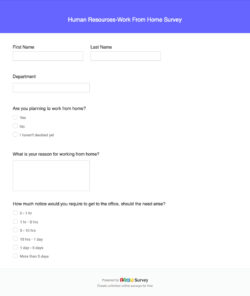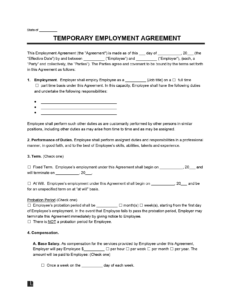The landscape of work has fundamentally shifted, with remote setups becoming not just a temporary solution but a long-term strategy for countless organizations. While the flexibility and autonomy remote work offers are invaluable, it also presents unique challenges that can impact employee well-being, productivity, and overall engagement. Understanding these nuances is crucial for fostering a supportive and thriving virtual environment.
This is where listening to your employees becomes paramount. A well-designed survey can provide invaluable insights into their experiences, concerns, and needs. By systematically gathering feedback, companies can identify areas for improvement, reinforce what is working well, and ultimately build a more resilient and connected remote workforce. Using a comprehensive remote work employee survey template is an excellent starting point for this vital process.
Why a Remote Work Employee Survey is Essential for Your Team
Moving to a remote work model, whether fully distributed or hybrid, introduces a new set of dynamics for employees. They might grapple with feelings of isolation, struggle with maintaining a healthy work-life balance when their office is also their home, or face challenges with communication and collaboration tools. Without a clear mechanism to voice these concerns, minor issues can escalate, leading to decreased morale, burnout, and even attrition.
A structured remote work employee survey provides a dedicated, anonymous channel for staff to share their honest feedback. It moves beyond casual check-ins, allowing you to systematically collect data across various aspects of their remote experience. This data is not just anecdotal; it is quantifiable information that can highlight trends, pinpoint specific pain points, and reveal opportunities for targeted interventions.
By regularly deploying such surveys, organizations can proactively address potential issues before they become major problems. It demonstrates to employees that their voices are heard and valued, fostering a culture of transparency and trust. This, in turn, can significantly boost engagement, productivity, and retention, proving that a thoughtful approach to remote work can lead to a more successful and harmonious team.
Investing in understanding your remote team’s needs through a survey is not just about problem-solving; it is about strategic growth. Happy, supported employees are more likely to be productive, innovative, and committed to their organization’s success. It’s an investment in your people, which translates directly into an investment in your company’s future.
Key Areas to Cover in Your Survey
- Communication Effectiveness: Are employees receiving clear instructions and feedback? Are team meetings efficient?
- Work Life Balance: Do employees feel able to disconnect from work? Is their workload manageable?
- Technology and Resources: Do they have the necessary tools and equipment to perform their job effectively from home?
- Engagement and Morale: Do employees feel connected to their team and the company culture? Are they motivated and feeling valued?
- Manager Support: Do managers provide adequate support, guidance, and empathy in a remote setting?
- Wellbeing: Are there resources available for mental and physical health support?
Crafting and Implementing Your Remote Work Employee Survey Template
Once you understand the importance of surveying your remote team, the next step is to design and implement your remote work employee survey template effectively. It is not just about asking questions; it is about asking the right questions in the right way and then acting on the responses. Begin by defining your objectives: what specific insights are you hoping to gain? Are you looking to improve communication, enhance well-being, or assess technology needs?
When drafting your survey questions, aim for clarity and conciseness. Use a mix of quantitative (e.g., Likert scales) and qualitative (open-ended text boxes) questions to get both measurable data and nuanced feedback. Ensure anonymity is guaranteed, as this encourages more honest and comprehensive responses. Employees need to feel safe sharing their true experiences without fear of reprisal. Clearly communicate the purpose of the survey and how the results will be used.
Distributing the survey can be done through various online platforms, making it accessible to all remote employees regardless of their location. Give employees a reasonable timeframe to complete the survey and send gentle reminders. Once the responses are collected, dedicate time to thoroughly analyze the data. Look for patterns, recurring themes, and significant outliers. Identify both areas of strength and areas that require immediate attention.
The most critical step, however, is taking action based on the survey results. Communicating the findings back to the employees, even if anonymously, is essential. More importantly, develop clear action plans based on the insights gained. Whether it’s implementing new communication tools, offering mental health resources, or adjusting workload expectations, showing your employees that their feedback directly leads to positive change reinforces their trust and commitment. This continuous feedback loop transforms a simple survey into a powerful tool for organizational growth and employee satisfaction.
In a world where remote work is increasingly the norm, understanding and responding to the needs of your distributed workforce is no longer optional; it is a strategic imperative. Utilizing a robust remote work employee survey template allows organizations to systematically gather critical feedback, identify challenges, and celebrate successes unique to the virtual environment. It provides a data-driven approach to nurturing a supportive, productive, and engaged team, no matter where they are located.
By prioritizing employee voice and consistently acting on insights gained, companies can transform potential remote work hurdles into opportunities for stronger team bonds and enhanced organizational performance. Investing in such feedback mechanisms ultimately cultivates a culture of adaptability and genuine care, ensuring your remote team feels valued, connected, and empowered to thrive.


